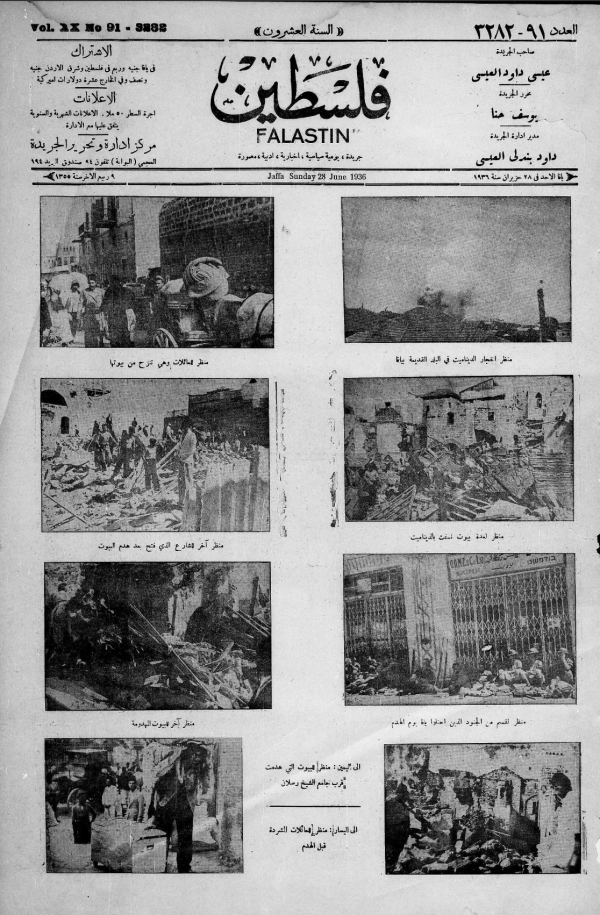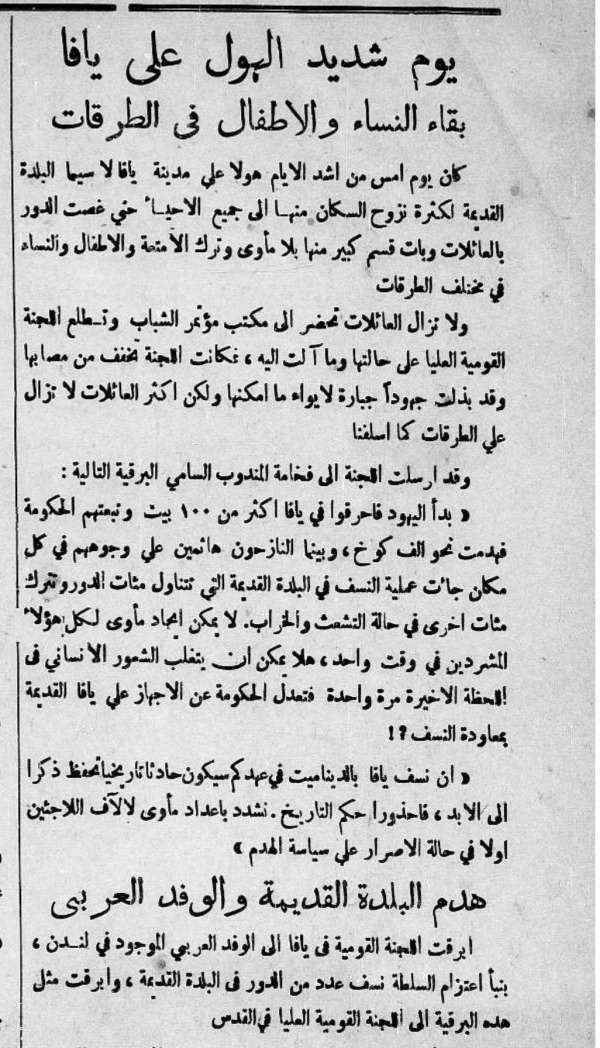
During the Great Arab Revolt, British General Peirse, the Commander-in-Chief, implemented a series of retaliatory measures against a group of cities, most notably the demolition of the Old City of Jaffa, aimed at restoring security and operating the port using non-striking workers, should they insist on continuing the strike. This contradicts Britain's claims that the demolition operation was aimed at improving and expanding the city and opening up roads in it.
In implementation of this, a warplane flying over the city issued the following warning: "The government is about to start a project aimed at expanding and improving the Old City of Jaffa, by building two roads that will benefit the entire city. The necessary first steps will begin by demolishing and removing some of the overcrowded and unhealthy buildings, taking advantage of the presence of Royal Engineers teams in Palestine to start this work."
Indeed, British forces carried out intense and targeted shelling operations to silence the sources of rebel gunfire, and the clashes continued for eighteen days until the British forces managed to take control of the city, forcing its residents to remove barricades and barriers before demolishing the old town.
The outcome of this operation was as follows:
The demolition of 220 houses inhabited by 450 families.
The demolition of 850 wooden barracks inhabited by 4,000 people.
The destruction and cracking of a number of houses, displacing ten thousand citizens.
Additionally, damage was inflicted on places of worship, especially the Church of St. George in the Ajami neighborhood, the Church of the Latin Monastery, and the Sheikh Raslan Mosque.
However, despite the strength and brutality of the operation, it did not achieve the strategic goal of the British occupation in ending the revolt and stopping the strike. Instead, it served as an incentive for the rebels to carry out a series of widespread operations across all of Palestine on the occasion of the hundredth day anniversary of the strike on July 27, 1936. This prompted General Peirse, the Commander-in-Chief of the British forces, to acknowledge his forces' inability to confront the rebels and to request the supply of a full military brigade and a squadron of fighter aircraft.
On the morning of June 16, 1936, a warplane hovering over the city issued the following warning: "The government is about to start a project aimed at expanding and improving the Old City of Jaffa, by building two roads that will benefit the entire city. The necessary first steps will begin by demolishing and removing some of the overcrowded and unhealthy buildings, taking advantage of the presence of Royal Engineers teams in Palestine to start this work."
Orders were issued to Major Outerson-Kells to conduct the necessary reconnaissance and develop a political plan in collaboration with Brigadier-General Crosby, the Southern District Governor, and his assistant, Chief Police Inspector Folly. Initially, a proposal was made recommending the use of infantry forces to occupy the city and then carry out the demolition operation. However, fear of significant losses among British forces made the execution of this operation conditional. In the end, the British leadership decided to implement the following plan, divided into four stages:
Intense and continuous gunfire against rebel positions until their fire was silenced.
Mandatory work imposed on the city's residents to remove barricades and barriers.
Demolition of the eastern and western areas of the Old City and the construction of a road through them.
Demolition of the northern and southern areas of the Old City and the construction of another road through its center.
The implementation of the first stage began with intensive gunfire targeting Arab snipers and their positions using Vickers machine guns with high firepower and effective impact compared to the primitive weapons of the rebels. These clashes continued for 18 consecutive days until the day the work began to implement the third stage on 18/6/1936. The success of the first stage led to the execution of the second stage. The British forces ordered the elders, shop owners, and residents in the affected area, after it was surrounded, to remove various barricades and barriers from the streets and restore order to them. The residents of the Old City woke up on the morning of June 16, 1936, to the sound of bells, calls, and leaflets dropped by an aircraft announcing the government's decision to start an operation (beautification of the city). It threatened to use force in case of any resistance to implementing the government's plan and promised to pay appropriate compensation to owners of demolished or damaged houses.
The first steps of the operation began at four o'clock in the morning on 18/6/1936 after an infantry battalion encircled the area and inspected everyone leaving it, while another battalion secured the necessary cover for the demolition team. Two infantry platoons and a third armored platoon were placed in reserve, in addition to the warship "Active," which was tasked with securing the area overlooking the sea. Thus, the demolition operation began. By evening, a road ten meters wide had been paved, extending from the Ajami Police Station in the east to the Latin Monastery in the west.
The success of the third stage of the operation led to the start of implementing the fourth stage shortly thereafter. Peirse stated that the reason for the speed in executing the final stage of the operation was to leave no room for the High Court to rule on the demolition operation after the Arabs lodged a complaint with it regarding this matter.
The demolition work to complete the fourth stage resumed on 29/6/1936 and was completed the following day after destroying some areas located north and south of the city.
It is evident from the preceding account the extent of the contradiction between the declared objectives of the British authorities and their true intentions in demolishing the Old City. It also reveals the extent of their aggression against the Arab population and their rights. This became particularly clear in their announcement of an unconvincing reason for demolishing the Old City twice within one month, first on 18/6/1936 and then on 29th and 30th June 1936. In the first instance, 70 houses housing 150 families were demolished, and in the second instance, about 150 houses housing around 300 families were destroyed. Approximately 850 wooden barracks housing about 4,000 people in other areas of the city were also removed. This resulted in the demolition and damage of a large number of adjacent houses. An estimated 10,000 people were left homeless. The damage extended to the Old City, affecting the Al-Khidr Church in the Ajami neighborhood, causing cracks due to the dynamite explosions. The Sheikh Raslan Mosque was also affected, with part of its minaret destroyed and stones scattered onto the Church of the Holy Sepulcher, causing significant damage to its roof and destruction of some of its hanging lamps. The Latin Monastery, known as the Citadel, was heavily affected by the dynamite, damaging its contents and disfiguring its exterior. However, the compensation promised by Britain to the affected individuals amounted to only twenty mils per person without undertaking any significant efforts to shelter these displaced persons.
Following these events, Peirse wrote to his superiors, stating, "The forces operating under my command are no longer capable of crushing the rebellion at the required speed. Therefore, I request the dispatch of at least two infantry battalions to form each brigade consisting of four battalions, in addition to two reserve battalions and a cavalry squadron specializing in limited missions, especially in the Jordan and Be'er Sheva regions."
Peirse further adds, stating: "It has become necessary in order to quickly restore calm to the country to deploy a complete brigade consisting of three divisions, including the forces already present in the country totaling 10,389 officers and soldiers, including the air force, under the command of the general commander. In addition to Squadron 33 of artillery originally stationed at the Ismailia base to carry out bombing operations."



Share your opinion